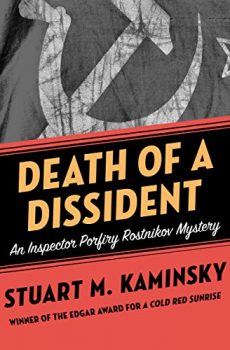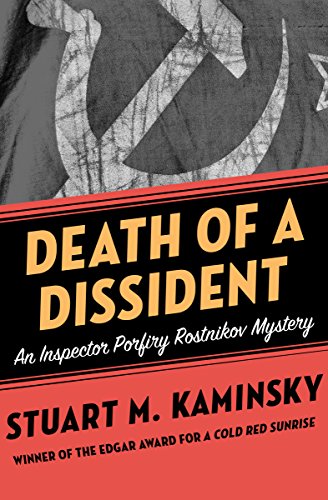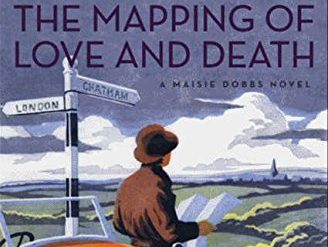
Set in the USSR not long after the Soviet invasion of Afghanistan, Death of a Dissident paints a savage if all too credible picture of life in Moscow early in the final decade of Communist rule. If you enjoy historical fiction and have a hankering to understand the lies, compromises, and inefficiencies that led to the collapse of Communism, you’ll enjoy this grim murder mystery set in the USSR. The novel is the first of sixteen in a series by Stuart Kaminsky featuring the veteran Soviet policeman Porfiry Rostnikov.
Estimated reading time: 5 minutes
A puzzling murder mystery set in the USSR
A dissident intellectual named Aleksander Granovsky is scheduled to go on trial the next day for crimes against the state when a lunatic murders him in his home. To Inspector Porfiry Rostnikov, the prime suspect in such cases would be the KGB, but why? Granovsky would surely be found guilty and executed within days.
Does it make sense that the secret police would have him killed to save themselves the possible embarrassment of a trial? Well, perhaps. But now that looks exceedingly unlikely since a cab driver turns up dead, apparently by the same lunatic. Suddenly, the case becomes even more puzzling. Yet he knows he can expect no help from either the KGB or Granovsky’s dissident friends.
Death of a Dissident (Inspector Porfiry Rostnikov #1 of 16) by Stuart M. Kaminsky (1981) 289 pages ★★★★☆
An engaging homicide detective
Rostnikov is an appealing figure. A police officer for more than thirty years, he is a veteran of the Great Patriotic War. The fighting had left him with a limp caused by shrapnel he caught during the battle of Rostov. To compensate for the appearance of weakness lent by his limp, he lifts weights and has become uncommonly well muscled and strong. He is also, by all accounts, a gifted investigator. However, Rostnikov has no ambition to move up the ranks and become a procurator, an outcome he’s convinced would never happen in any case as his wife is Jewish.
Rostnikov is the father of two adult children. His son, Iosif (“rashly named for Stalin”), has joined the army. Midway through his inquiry into the murders he learns that Iosif has been transferred to the front in Afghanistan. “Iosif was in a place where Russian soldiers were being killed. Visions of his own war, of death, of Rostov, sliced through Rostnikov.” And that will prove to be a complication as Rostnikov’s investigation unfolds.
The investigator’s two subordinates are both intriguing
In what seems a setup for the subsequent novels in this series, Rostnikov works with two subordinates. Emil Karpo is a cadaverous veteran known to many as “the Tatar” for his Asian looks. He “had not a single friend, which suited him. He would tolerate no slackness in others and radiated cold, silent fury toward those who did not devote themselves fully to their tasks, particularly the seemingly endless task of cleansing Moscow.” Sasha Tkach is bright and resourceful though much younger and as yet unproven.
An ironic ending to this murder mystery set in the USSR
In the end, it is Rostnikov himself who deduces the truth about the killings. He “would not, could not accept the simple explanation for murder that one was mad, even madness had its own logic.” That insight proves to be the key. And yet the truth is often an orphan in the Soviet system. “‘There are times,’ his boss explains, ‘when it is best to forget about being a policeman and accept political truth and expediency.'” There’s irony aplenty in the ending.
About the author
Stuart M. Kaminsky (1934-2009) authored four series of mystery novels, including three that ran to at least ten volumes each. (The other two featured a private detective in 1940s Hollywood and a veteran Chicago police officer.) Kaminsky won the Edgar Award for Best Novel for one of the Inspector Rostnikov books. As he wrote in his Introduction to Death of a Dissident, “I knew a great deal about Russia . . . All of my grandparents were born in Russia and I had many a remembered tale to draw upon.” It’s clear from my own reading—and from my two visits to the USSR, in 1965 and 1989—that Kaminsky understood his subject matter.
For related reading
This is one of a superb series of Police procedurals spanning modern Russian history.
I’ve also reviewed the four books that follow Death of a Dissident in the Porfiry Rostnikov series:
- Black Knight in Red Square (The collapse of the USSR is underway in this detective novel)
- Red Chameleon (A Russian police procedural set in the Soviet Union)
- A Fine Red Rain (In Gorbachev’s Russia, corruption and a serial killer)
- A Cold Red Sunrise (A historical mystery about a murder above the Arctic Circle)
I’ve also read detective novels set in the Soviet Union by three other authors. Most of the books are excellent. The best known of the writers is Martin Cruz Smith.
- Wolves Eat Dogs – Arkady Renko #5 by Martin Cruz Smith (Martin Cruz Smith addresses what really happened at Chernobyl)
- Tatiana – Arkady Renko #8 by Martin Cruz Smith (A crusading Russian journalist and the Mafia)
- The Holy Thief – Captain Alexei Korolev #1 by William Ryan (A terrific murder mystery set in Stalins Soviet Union)
- The Twelfth Department – Captain Alexei Korolev #3 by William Ryan (An intimate look at Stalin’s terror)
- Agent 6 – Leo Demidov #3 by Tom Rob Smith (A superb suspense novel set in the USSR, Afghanistan, and the U.S.)
You might also enjoy my posts:
- Top 10 mystery and thriller series
- 20 excellent standalone mysteries and thrillers
- 30 outstanding detective series from around the world
- Top 20 suspenseful detective novels
- Top 10 historical mysteries and thrillers
And you can always find my most popular reviews, and the most recent ones, on the Home Page.



























